
by best-mag | Travel
we want to show you 7 historical places in Isfahan. Isfahan is one of the most beautiful cities in Iran and the world.
1-The first place to visit is the most beautiful and best church in Iran, the 400-year-old Vanak Church :

This church is located in Jolfa neighborhood of Isfahan and is one of the Armenian churches of Isfahan. This church was built 400 years ago during the reign of Shah Abbas II The ticket price for foreign tourists is 100 thousand tomans or about 2 dollars and 50 cents.
2- One of the best places to visit in Isfahan is Naqsh Jahan Square:
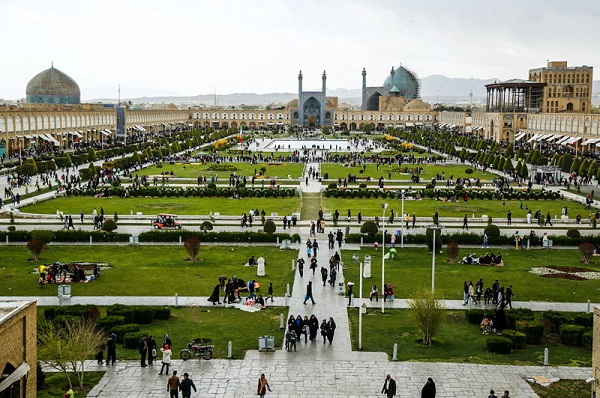
There are many places of interest in this square. One of them beautiful mosque. This is Imam Mosque or Shah Mosque. Let’s go see together. The ticket price for tourists is 100 thousand tomans or about 2 dollars and 50 cents. The price of each dollar in Iran today is 42 thousand tomans.
3-Imam Mosque or Shah Mosque :
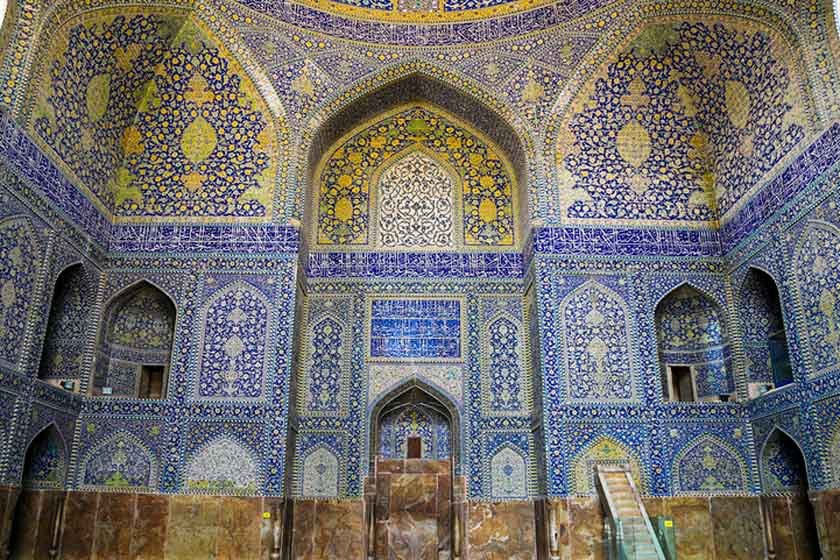
is the most important mosque of Safavid era in Isfahan. This mosque has great grandeur. If you are here you feel it. This mosque was built during the time of Shah Abbas and around 410 years ago.
4-One of the most beautiful and historical places in the city of Isfahan is Ali Qapo mansion:

This mansion is located in Naqsh Jahan square This mansion was built 400 years ago during the Safavid era. At that time, the king used this mansion to carry out state affairs The ticket price for tourists is 2 dollars and 50 cents. One of the must-see places in Isfahan is Naqsh Jahan Square. There is an old and historical market in this square. This is Isfahan market. You can see and buy souvenirs of Iran and the city of Isfahan, such as various types of copper dishes, inlay work, enamel work, tile making, and all kinds of delicious sweets such as Gaz.
5-One of the most unique places to visit in Isfahan is Chehl Seton Palace :
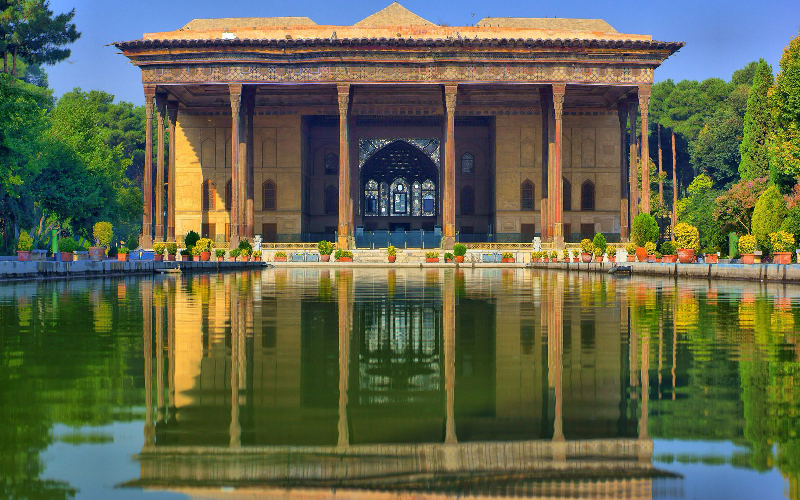
This palace is close to Naqsh Jahan Square. Chehel soton Palace has an area of about 67 thousand square meters. This building was built during the time of Shah Abbas A.L. Shah Abbas was one of the greatest kings of Iran who built many buildings in Iran and the city of Isfahan This palace was used to receive special guests. the ticket price is 2 dollars and 50 cents.
6- The sixth historical place of Isfahan is thirty-three bridges :

This bridge is located on the most beautiful river in Isfahan. This bridge is in the center of Isfahan city. It has 33 columns, 295 meters long and 14 meters wide. This bridge was built about 400 years ago. At that time, this bridge was used for important ceremonies and celebrations. Many tourists consider this bridge to be a masterpiece of world architecture and one of the most beautiful bridges in the world.
7-The last place is chahar bagh Street :

An old and beautiful street in the center of Isfahan I suggest you come to this street at night and enjoy walking in it. Isfahan has many places to see, such as Minarjanban, Sheikh Lotfollah
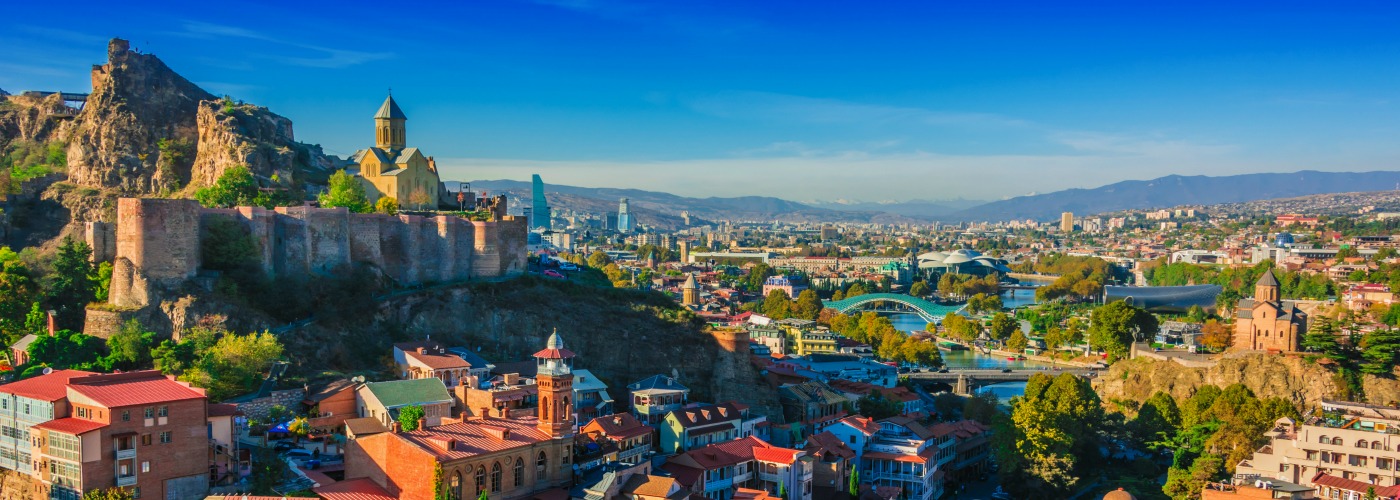
by best-mag | Travel
we go to the most famous symbol of the city of Tbilisi .Tbilisi is the capital of the country of Georgia
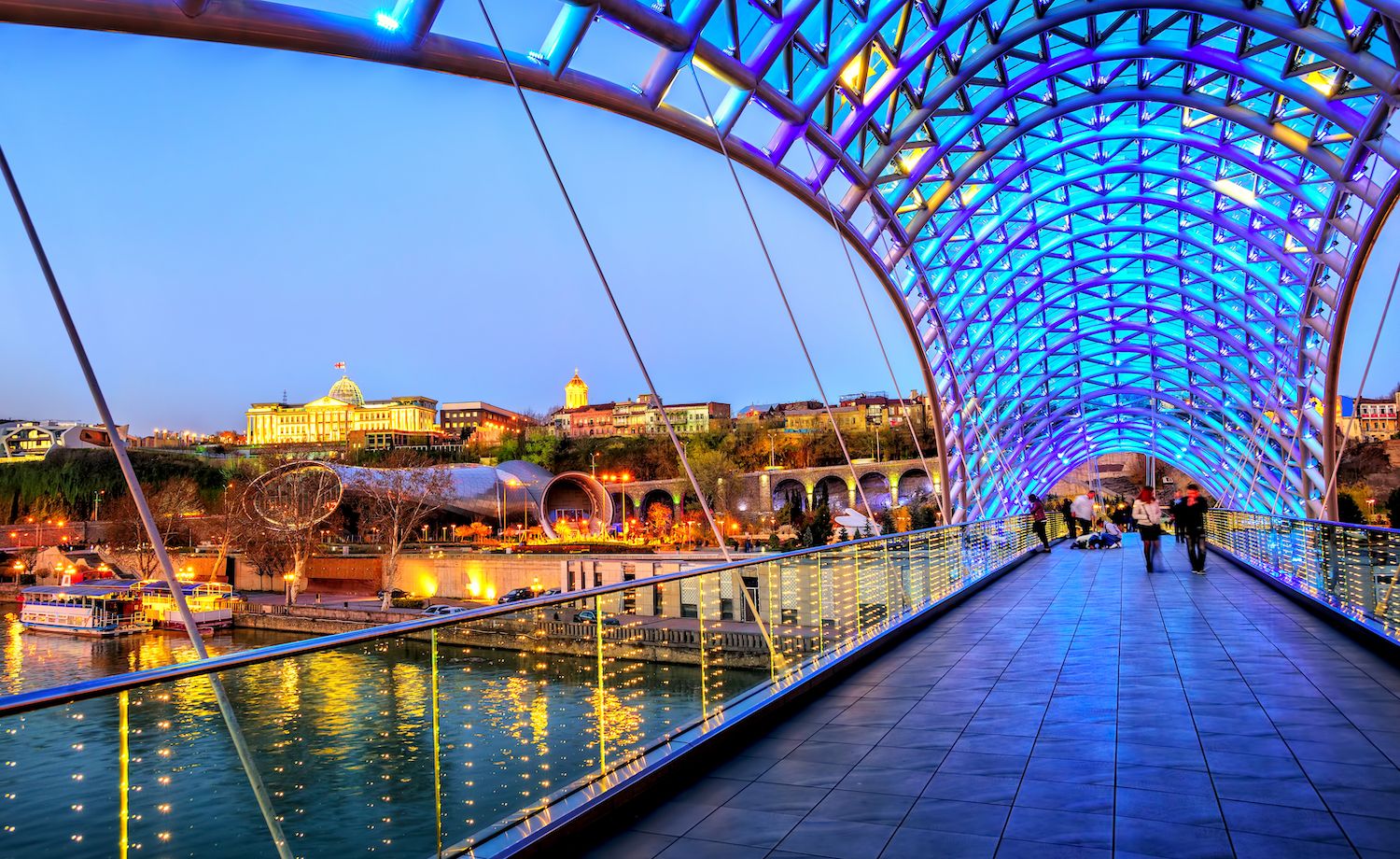
1.Bridge of Peace In Georgian :
this bridge is called “mshvidobis khidi”. The 150m long arching bridge is made of steel and glass and is embezzled with numerous LEDs and lights. This wonderful landmark is located in the center of Tbilisi, on the Kura River, and connects old and new Tbilisi. The bridge was officially opened on May 6, 2010. Strolling atop the bridge gives you a breathtaking view of the Mtkhi Cathedral, the statue of King Vakhtang Gorgasali and the Narikala Castle on the one side , and the Baratashvili Bridge and the Presidential Office building, on the other. Of course, the bridge structure, with the use of thousands of LEDs in the walls and lights in its curved curtain, attracts the eye of every tourist at night. Interestingly, the design of the bridge was done by Michael Dolcichi an Italian, and lighting by French philosopher Martínez The construction of this huge structure took place in Italy it was then moved to Tbilisi by land.
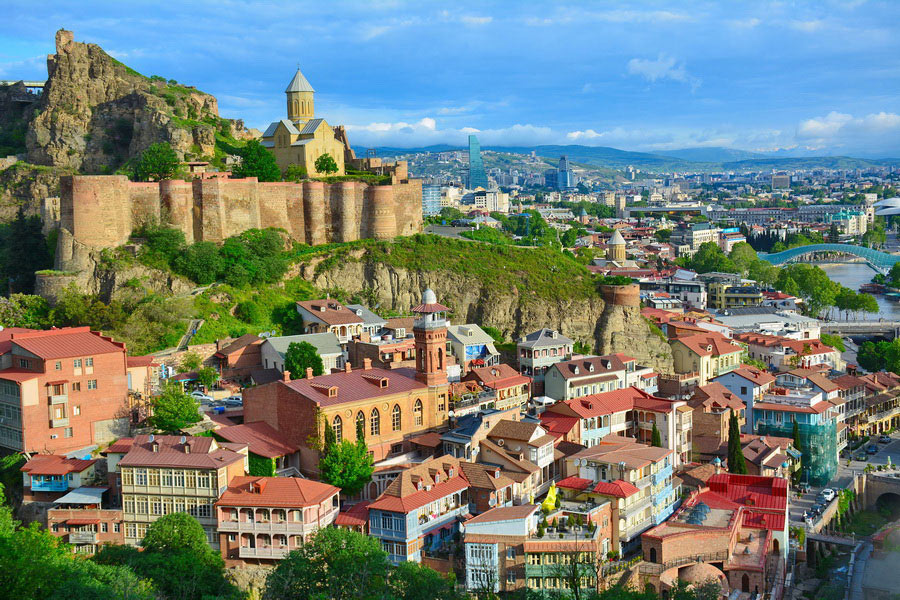
2.Narikala castle :
overlooking the city of Tbilisi and the river Kura. This castle is on a steep slope of a hill, consisting of two sections, the sulfur baths and the Tbilisi Botanical Garden separated by walls. A 13th century castle once stood at the base of the castle, where it burned down and was eventually replaced, in 1996 and 1997, by the St. Nicholas church. The interior walls of this church are depicted in pictures of Georgian history as well as narrations of the Bible. This castle was built in the 4th century AD in the style of Iranian architecture, and was considered by the King of David in the seventeenth century as part of the Umayyad caliphate The moguls did not miss this monument in their attack on the city and renamed it to Narikala (small castle). Many of the remains of this castle, which are visited by tourists today, are related to the 16th and 17th centuries, and the rest of it has been lost in various wars. Parts of the castle were damaged in the earthquake that rocked the city of Tbilisi in 1827.
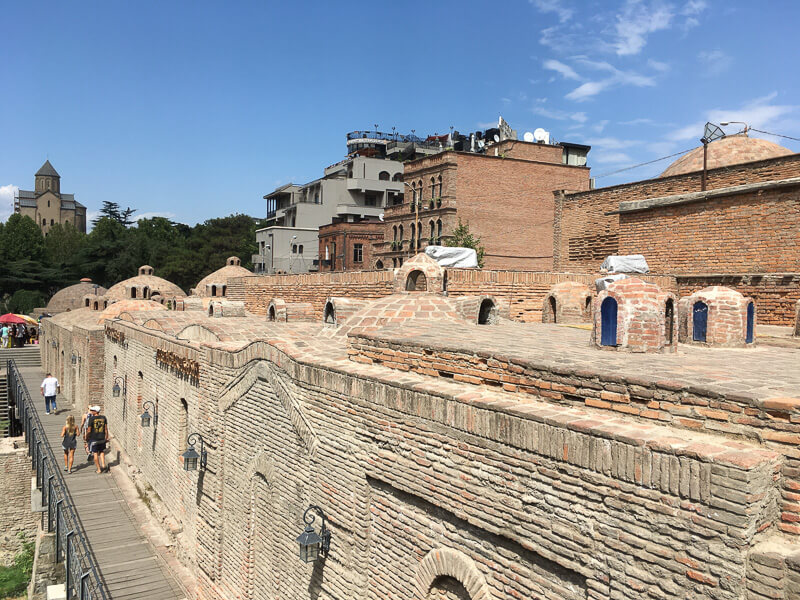
Historical discussions Tbilisi:
Vakhtang was one of the last Kings of Iberia, who reigned in the 5th century, and was of the Chosroid Dynasty who were a dynasty of Iranian Mihranid origin, accepted Christianity as their official religion, and maneuvered the Byzantine Empire and Sassanid Iran to retain a degree of independence. Vakhtang I has always been an endeared historical figure of Georgian culture, even referred to as a Saint by the Georgian Church. There are many recorded names in different historical text when referring to Vakhtang I, among which are Gorgasali meaning “Wolf-bodied” -with possible references to the wolf cult of Georgia or the wolf shaped hat that he wore, and the Persian name Varaz Khosrovtang which is said to have been rendered Vakhtang in Georgian. Vakhtang I was born in 440 AD in Mtskheta to Mihrdad V -a Georgian King and Sagdukht, a Persian Princess. He later married the Sassanid Princess Balendukht at the age of 19. It is said that King Vakhtang I gave chase to a Pheasant The King’s falcon allegedly caught or injured a pheasant during the hunt, after which both birds fell into a nearby hot spring and died from burns He dazzled by the warmth of the spring and he ordered his men to start building a settlement and named it Tbilisi meaning “The Holder of Hot Springs” which is now the capital city of Georgia. Once the Hundred Years Peace between Iran and Rome collapsed, Kavad I of the Sassanids summoned Vakhtang as a vassal to join in a new campaign against Rome Vakhtang refused, provoking an Iranian invasion of his kingdom. Then about 60, he had to spend the last years of his life in war and exile, fruitlessly appealing for the Roman aid. Vakhtang entered a pantheon of Georgian historical heroes already in the Middle Ages. In popular memory, his image has acquired a legendary and romantic façade. Vakhtang is a subject of several folk poems and legends, extolling the king’s perceived greatness, enormous physical strength, courage and devoutness to Christianity. In Tbilisi there is a street and a square bear his name, and a 1967 monument by the sculptor Elguja Amashukeli tops the Metekhi cliff. Tbilisi has long been a place for all religions The Juma Mosque of Tbilisi is a testament to the fact. The mosque, also known as Tbilisi Mosque, is located in the Botanikuri area near the Sulfur Baths, and is a place for worship for Sunni and Shiite Muslims. The building was built in 1700 by the Ottoman Empire and was destroyed and rebuilt three times during 300 years.
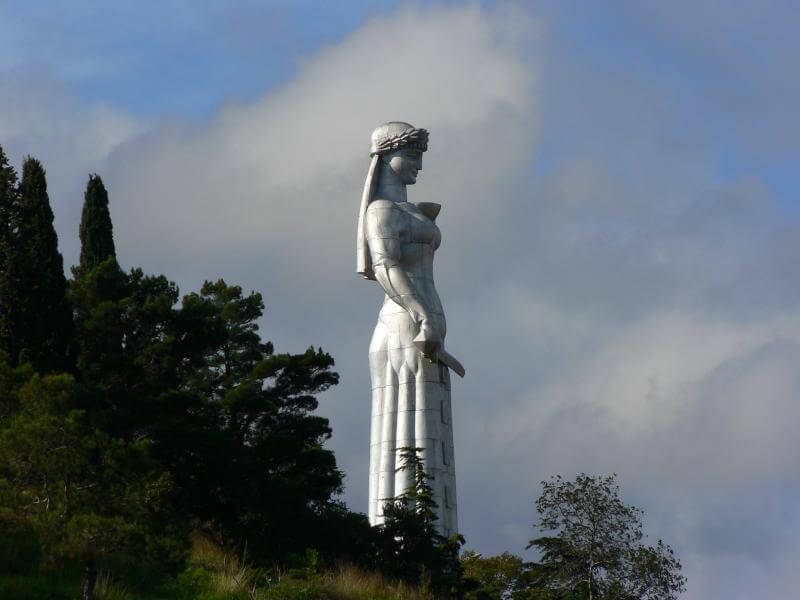
For a very long time Georgian Muslims, which make up 10% of the country’s population held their prayers in 2 mosques. Juma Mosque for Sunnies and the Blue Mosque for the Shiite. However, in 1951, the Blue Mosque was demolished by the Soviet Government to make way for a bridge leaving Shiite Muslims without a place of worship. At that time, the doors of the Juma Mosque were opened on the Shiite Muslims and making it one of the few mosques in which both Shiite and Sunni Muslims pray. Until 1996, a black curtain separated the two groups, but since then Shia and Sunni Muslims have been worshiping alongside each other. The Svetitskhoveli Cathedral is an orthodox church located in the historic city of Mtskheta, in the northwest of Tbilisi. The early medieval masterpiece introduced by UNESCO as a World Heritage Site. The main building of this church dates back to the 4th century, but what we are now witnessing was built in 1029. It is said that the St. Nino a woman who introduced Christianity to Georgia or Iberia, built this monument where the two rivers, the Kura and Aragvi meet. Choosing this place has a long story. In summery, According to Georgian hagiography, in the 1st century AD a Georgian Jew from Mtskheta named Elias was in Jerusalem when Jesus was crucified. Elias bought Jesus’ robe from a Roman soldier at Golgotha and brought it back to Georgia. Returning to his native city, he was met by his sister Sidonia who upon touching the robe immediately died from the emotions engendered by the sacred object. The robe could not be removed from her grasp, so she was buried with it. The place where Sidonia is buried with Christ’s robe is preserved in the Cathedral. Later, from her grave grew an enormous cedar tree. Ordering the cedar chopped down to build the church, St. Nino had seven columns made from it for the church’s foundation. It was further said that from the magical seventh column a sacred liquid flowing through that cured people of all diseases. In Georgian sveti means “pillar” and tskhoveli means “life-giving” or “living”, hence the name of the cathedral. The existence of this church in Mtskheta made it the capital of the country before the king of Vakhtang selected Tbilisi as the capital, which, of course, is known by the Georgians as the religious capital of the country. The church withstood a lot of damage throughout its history but was rebuilt. It is not bad to know that there are important people buried inside the church such as Vakhtang Gergasali, the founder of the city of Tbilsi, the king of Hercules, the king of Kakheti , the first wife of Gorgin Khan, one of the Kartli kings of the time of the Safavids, King David VI of Iberia the eighth Georgi the last of the Iberian king Some members of the royal family. The name of the constructor was Arsukidze. In the outer wall of the northern wall, there stands a magnificent statue of a hand-held hammer, the text underneath it reads: “This is the hand of the Arsukidze, the slave of the Lord, God forgive him.” He never met the completion of his masterpiece and died before the church was completed. The Holy Trinity Cathedral of Tbilisi (Tbilisis cminda samebis sakatedro tadzari) , also known as the Samba, is the main Orthodox church in Georgia, located at the heart of Tbilisi. The construction of this building lasted from 1995 to 2004 It is the third-tallest Eastern Orthodox cathedral in the world and one of the largest religious buildings in the world by total area. Sameba is a synthesis of traditional styles dominating the Georgian church architecture at various stages in history and has some Byzantine undertones The idea to build a new cathedral to commemorate 1,500 years of autocephaly of the Georgian Orthodox Church and 2,000 years from the birth of Jesus emerged as early as 1989, a crucial year for the national awakening of the then-Soviet republic of Georgia. In May 1989, the Georgian Orthodox Patriarchate and the authorities of Tbilisi announced an international contest for the “Holy Trinity Cathedral” project. No winner was chosen at the first round of the contest when more than a hundred projects were submitted. Finally the design by architect Archil Mindiashvili won. The subsequent turbulent years of civil unrest in Georgia deferred this grandiose plan for six years, and it was not until November 23, 1995, that the foundation of the new cathedral was laid eventually finishing construction on November 23, 2004 on the day of the Georgeba (one of the religious ceremonies of Georgia). The dome of this church is 7.5 meters high and is made of gold. The total height of the ground floor is 81.7m underground height is 13 meter. It is interesting to note that this building is not just a single church, but consists of 9 smaller churches. Jvari Monastery s a sixth century Georgian Orthodox monastery near Mtskheta, eastern Georgia Along with other historic structures of Mtskheta, it is listed as a World Heritage site by UNESCO from 1994. Jvari Monastery stands on the rocky mountaintop, overlooking the town of Mtskheta, which was formerly the capital of the Kingdom of Iberia. According to traditional accounts, on this location in the early 4th century Saint Nino a female evangelist credited with converting King Mirian III of Iberia to Christianity, erected a large wooden cross on the site of a pagan temple. The cross was reportedly able to work miracles and therefore drew pilgrims from all over the Caucasus. A small church was erected over the remnants of the wooden cross in c.545 named the “Small Church of Jvari”. Kartlis Deda or the Mother of Georgia was erected on the top of Sololaki hill in 1958, the year Tbilisi celebrated its 1500th anniversary. Prominent Georgian sculptor Elguja Amashukeli designed the twenty-metre aluminium figure of a woman in Georgian national dress. She symbolizes the Georgian national character: in her left hand she holds a bowl of wine to greet those who come as friends, and in her right hand is a sword for those who come as enemies. This square has witnessed many events throughout history. Referred to by the locals as Tavisupleba now a days this lively square has had different names throughout the years. The square was originally named after Ivan Paskevich, the Count of Erivan, a Ukrainian general of the Russian Imperial Army, who earned his title in honor of his conquest of Erivan (present-day Yerevan) for the Russian Empire. Under the Soviet Union, the square was renamed, first “Beria Square”, and then “Lenin Square”. The location was first named Freedom Square in 1918, during the foundation of the First Georgian Republic following the collapse of the Russian Empire. Freedom Square was the site of the 1907 Tiflis bank robbery. Freedom Square has also been the site of various mass demonstrations including those for Georgia’s independence (from the Soviet Union), the Rose Revolution, and others. In 2005 Freedom Square was the location where U.S. President George W. Bush and Georgian President Mikheil Saakashvili addressed a crowd of around 100,000 people in celebration of the 60th anniversary marking the end of World War II During this event, Georgian-Armenian Vladimir Arutyunian threw a live grenade at President Bush while he was speaking in an unsuccessful attempt to assassinate him Tbilisi City Hall is situated on the Square. Other buildings include the former Bank of Georgia head office and the Marriott International Tbilisi. The square will also accommodate the Old Tbilisi local government office, the building works of which are already started. Abutting the north side of Freedom Square is a small open space with a fountain and a bust of Alexander Pushkin. During the Soviet period, the square featured a large statue of Vladimir Lenin, which was symbolically torn down in August 1991 On November 23, 2006, the Liberty Monument depicting St George slaying the dragon, created by Zurab Tsereteli was unveiled in the same place. Rustaveli Avenue formerly known as Golovin Street, is the central avenue in Tbilisi named after the medieval Georgian poet, Shota Rustaveli. The avenue starts at Freedom Square and extends for about 1.5 km in length, Rustaveli is often considered the main thoroughfare of Tbilisi due to a large number of governmental, public, cultural, and business buildings that are located along or near the avenue. The former Parliament of Georgia building the Georgian National Opera Theater the Rustaveli State Academic Theater the Georgian Academy of Sciences Kashveti Church Simon Janashia Museum of Georgia (part of the Georgian National Museum), and Biltmore Hotel Tbilisi among others, are all located on Rustaveli. In 1989, tens of thousands of Georgians gathered before the House of Government on Rustaveli Avenue. An attack by the Soviet Spetsnaz forces killed many protesters in the April 9 tragedy. Despite all its difficulties and tragedies this avenue has flourished as a place for happiness and celebration turning it into
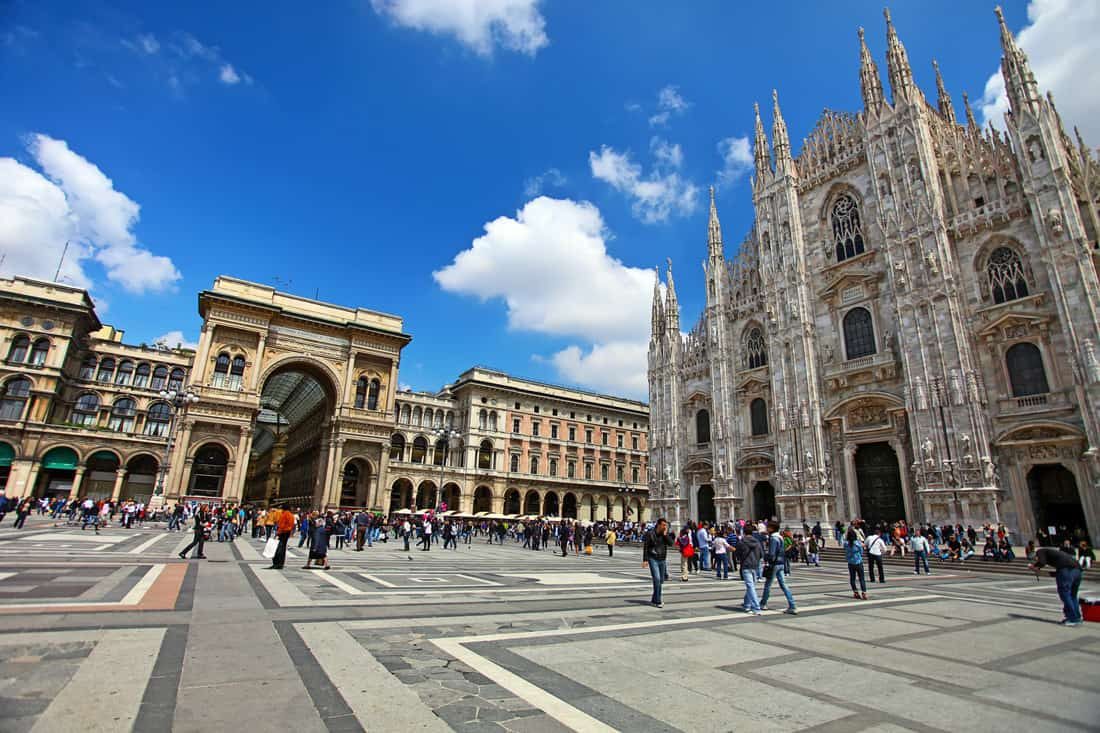
important tourist destination of Tbilisi :
The Tbilisi sea is an artificial lake in the vicinity of Tbilisi that serves as a reservoir. It was opened in 1953 and has become a popular recreation spot. Camping, swimming, fishing and sailing are among the popular activities carried out by thousands of tourists every day. The water park Gino Paradise famously hosts a variety of excellent recreational activities at Tbilisi Sea. It is planned to develop the Tbilisi sea into a recreational park with various sports facilities. The lake has a length of 8.75 km and a width of 2.85 km and for travelers flying into Tbilisi International Airport, it is visible just before landing.
The National Botanical Garden of Georgia, formerly the Tbilisi Botanical Garden is located in the Tsavkisis-Tskali Gorge on the southern foothills of the Sololaki Range it occupies the area of 161 hectares and possesses a collection of over 4,500 taxonomic groups. Its history spans more than three centuries. It was first descri bed, in 1671, by the French traveler Jean Chardin as royal gardens which might have been founded at least in 1625 From 1888 on, when a floristics center was set up, Yuri Voronov and several other notable scholars have worked for the Garden Between 1932 and 1958, the territory around the former Muslim cemetery was included in the botanical garden Several graves have survived however, including that of the prominent Azerbaijanian writer Mirza Fatali Akhundov (1812-1878). The central entrance to the Garden is located at the foothills of the Narikala Fortress. The other, cut through the rock as a long tunnel in 1909-14, had been functional until the mid-2000s when the tunnel was converted into Georgia’s largest nightclub “Gvirabi”.
visit to the breathtaking nature parks of this city. One of most beautiful of these locations is the Turtle Lake. This National Park is located in the suburbs of Tbilisi and is named after the large population of turtle which call it their home. Some know this lake by its Georgian name of Kus Tba. Turtle Lake is located on the wooded northern slope of Mtatsminda Mount at elevation of 686.7m above sea level The Turtle Lake area is designed as a recreational zone and is frequented by the Tbilisians on weekends. It is also a place where festivals and concerts are held It can be reached either via a road or an aerial tramway leading from Tbilisi’s Vake Municipality the tramway is open from 8:00 until 22:00 and costs 1 lari in each direction.
Lisi lake is a small lake in the vicinity of Tbilisi, Georgia. The lake and surrounding area provide a habitat for variety of different species of exotic birds In addition to various avian species, the area around the lake provides shelter to a variety of animals such as turtles, foxes and hares. The area is well known for the large population of snakes the live in the hillsides around the lake. There is a Warm, Mediterranean, and reasonably dry climate in the vicinity of Lisi Lake There is a Warm, Mediterranean, and reasonably dry climate in the vicinity of Lisi Lake This lake is also where the annual Tbilisi Open Air concerts are held.
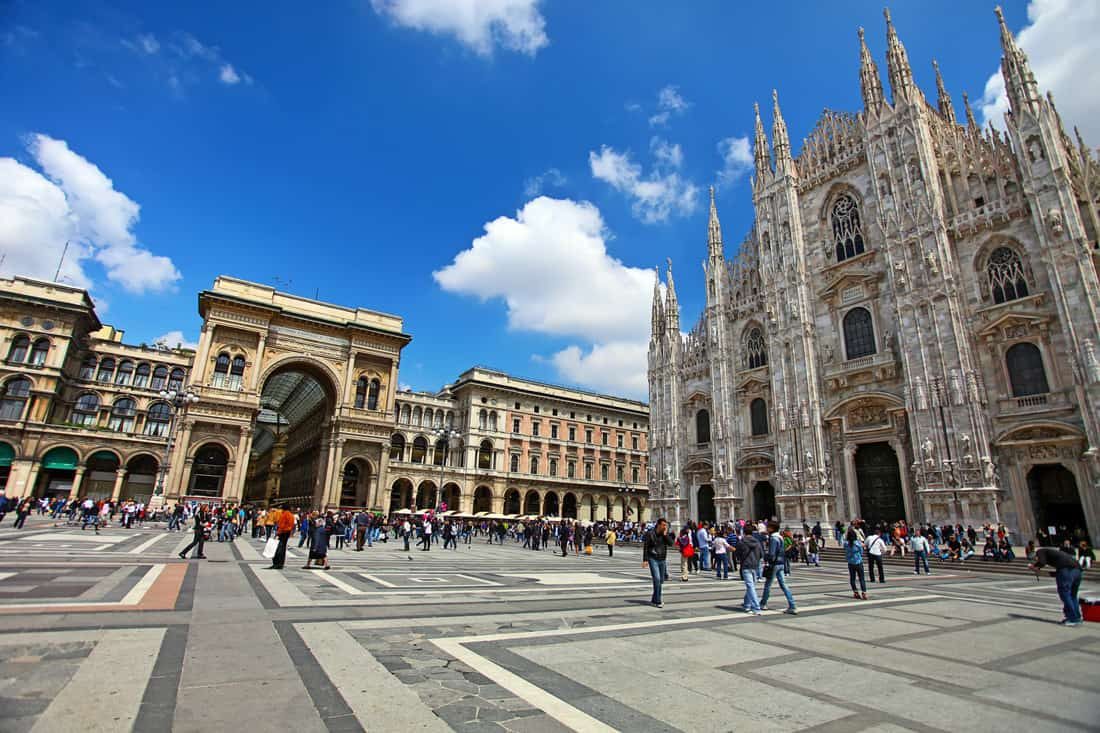
by best-mag | Travel
we are in milan right now city of mode and design we are in Parco Sempione, the largest park in milan look at this beauty behind me the park was built in under the Napoleonic rule after so many years this is still the bigest park in milan can you believe? this building was designed by leonardo da vinci.this building is by da vinci this castle behind me is in the largest park in milan it was built in the year 1450 that means about 570 years ago very great architects and artists like da vinci and Cesare Cesariano and inside it there is a museum with so many arts from da vinci and Michelangelo the ticket is only 12 euros here looks like portugal this is arc the peace its origins can be traced back to a gate of the Roman walls of Milan but the arc was built in 1807 so about 215 years ago why they call here arc the peace? In 1816 when the Napoleonic Kingdom of Italy fell and Milan was conquered by the Austrian Empire They called this place arc the peace I have to say .
We are on the Via Dante street it started raining and anything gonna be wet soon at the end of the Via Dante street was the Castello Sforzesco Castle with the Davinci painting and when you go the street straight ahead we cant still see any thing but the most famous Cathedral of city Milan guys! Im so excited look at this the third biggest Cathedral in the world in Milan look at this building look how beautiful this is look all this details did you know this building took nearly seven centuries to complete On 20 May 1805, Napoleon Bonaparte, about to be crowned King of Italy ordered the façade to be finished by Pellicani and after 700 years, finally was done we are front of the one of the bigest cathedral in the world and want to visit the inside As I said this building took nearly seven centuries to complete Why so long? in those days the had to take somehow this huge marble stones to the city center so many Engineers and Leonardo Davinci designed a system of interconnected canals in and around Milan So they could get the stones from there to here by cows Thats why this building took nearly seven centuries we are on the roof of the cathedral this is so cool!
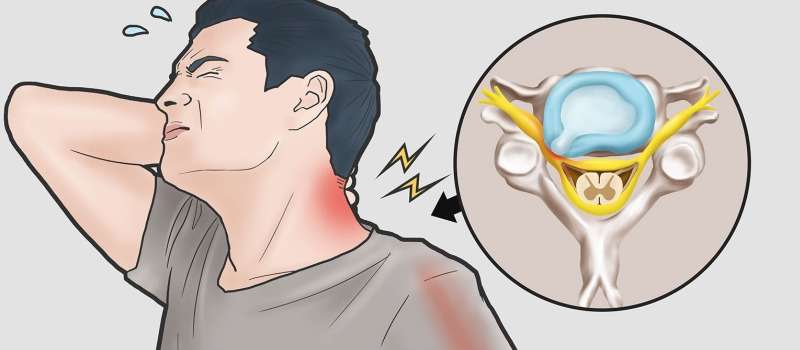
by best-mag | medicine
A cervical disc is a shock-absorbing, soft pad that lies between vertebrae in the cervical spine (the neck). The cervical spine is comprised of six total cervical discs. With the natural wear and tear that accompanies aging, a cervical disc may begin to degenerate, with some patients not even experiencing any symptoms.Cervical discs support the neck’s vertebral bones while also enabling flexibility for head movements. Sitting between adjacent cervical vertebrae stacked atop each other, each cervical disc acts as a shock absorber to help the cervical spine handle various stresses and loads.Cervical degenerative disc disease is a common cause of neck pain and radiating arm pain. It develops when one or more of the cushioning discs in the cervical spine starts to break down due to wear and tear.A bulging disc in your neck may be relatively painless. Or it can cause severe pain in your neck, as well as your shoulders, chest, and arms. It may also cause numbness or weakness in your arms or fingers. Sometimes, this pain and numbness may even cause you to think that you’re having a heart attack.

What is cervical disc ?
The
cervical disks are
the cushions that lie between the cervical vertebrae. They act as shock absorbers to allow your neck to move freely. Your cervical spine also forms a protective tunnel for the upper part of your spinal cord to pass through.Symptoms of c5-c6 disc herniation can include numbness, tingling, burning, weakness, problems with vision, and more.
What is a cervical herniated disc ?
Cervical discs are the cushions between the vertebrae in the upper back and neck. Herniation of the disc occurs when the gelatinous inner disc material, the nucleus pulpous, ruptures, or herniates, through the outer cervical disc wall.Cervical disc herniation is the result of the displacement of the nucleus pulposus of the intervertebral disc, which may result in impingement of these traversing nerves as they exit the neural foramen or directly compressing the spinal cord contained within the spinal canal.In some patients, a cervical herniated disc can cause spinal cord compression, where disc material pushes on the spinal cord. This is a much more serious condition and may require a more aggressive treatment plan. Spinal cord compression symptoms include: Awkward or stumbling gait.
Most cases of cervical herniated disc pain can be successfully managed with nonsurgical treatments, such as over-the-counter pain medications, physical therapy to strengthen and stretch the neck, ice or heat packs, and/or activity modifications to avoid painful movements until the pain has subsided.Treatment with rest, pain medication, spinal injections, and physical therapy is the first step to recovery. Most people improve in 6 weeks and return to normal activity. If symptoms continue, surgery may be recommended.In most cases cervical disc herniations improve with time and symptomatic treatment. This can take 6-12 weeks. Improvement is usually seen within 2-3 weeks and full recovery in the ensuing 2-3 months.
cervical disc surgery :
Anterior cervical discectomy and fusion (ACDF) is a surgery to remove a herniated or degenerative disc in the neck. An incision is made in the throat area to reach and remove the disc. A graft is inserted to fuse together the bones above and below the disc.Cervical disk replacement surgery involves removing a diseased cervical disk and replacing it with an artificial disk. Before this procedure was available, the affected disk was removed and the vertebrae above and below were fused together to prevent motion.The success rate of cervical spine surgery is very high, but complications have been reported. “The take away is that most of the complications were very rare, some were almost nonexistent,” Buser and Wang said. “Dural tear and C5 palsy were the most common, but again, they had a very low frequency.
spine MRI :
A cervical (SER-vih-kul) spine MRI can detect a variety of conditions in the neck and upper back area, including problems with the soft tissues within the spinal column, such as the spinal cord, nerves, and disks.MRI can produce the most reliable snapshot of the spine that promotes the accurate diagnosis of a herniated disc.A cervical MRI (magnetic resonance imaging) scan uses energy from strong magnets to create pictures of the part of the spine that runs through the neck area (cervical spine). MRI does not use radiation (x-rays). Single MRI images are called slices. The images can be stored on a computer or printed on film.
Questions About Cervical Disk Disease ?
Is walking good for herniated disc?
Absolutely. Walking is an excellent choice for patients with herniated discs, as it stimulates blood flow and oxygen to the cells. It also helps keep your discs hydrated, which is important for healing. Other low-impact aerobic activities to try are swimming and cycling
Is bed rest good for slipped disc?
The optimal sleeping position for a herniated disc is on your back. Lying on your back keeps your spine in a neutral position so you have less chance of pinching the nerve. For added comfort, nestle a small pillow or rolled-up towel under your knees and lower back.Most often 1-2 days of strict bed rest will calm severe back pain. Bed rest should not exceed 48 hours. Once you are back into your daily routine, you should take frequent rest breaks throughout the day- but avoid sitting for long periods of time.If you have a herniated disc, you may want to try sleeping on your side curled in a fetal position:
-Lay on your back and then roll over gently onto your side.
-Tuck your knees toward your chest and gently curl your torso toward your knees.
-Remember to switch sides from time to time to prevent any imbalances.
Is a hot bath good for a slipped disc?
Applying Heat, via a heating pad or heat wrap, even a hot bath may help muscle spasms in the first 2 days of initial pain. Heat helps soft issues to stretch, dilates blood vessels and decreases pain signals giving some relief to the discomfort.
Does massage help slipped disc?
Deep Tissue Massage: There are more than 100 types of massage, but deep tissue massage is an ideal option if you have a herniated disc because it uses a great deal of pressure to relieve deep muscle tension and spasms, which develop to prevent muscle motion at the affected area.
What happens if a cervical herniated disc goes untreated?
Untreated herniated discs with symptoms can become more painful and debilitating as time goes on. You may also experience bladder and bowel dysfunction and saddle anesthesia, so-called because it affects the areas on your body that would touch a saddle if you were sitting on a horse.
Is cervical surgery safe?
Although cervical disc surgery is generally safe, it does have a few risks, including.Some risks related to neck surgery can include:
bleeding or hematoma at the surgical site.
infection of the surgical site.
injury to the nerves or spinal cord.
leakage of cerebral spinal fluid (CSF)
C5 palsy, which causes paralysis in the arms.
degeneration of areas adjacent to the surgical site.
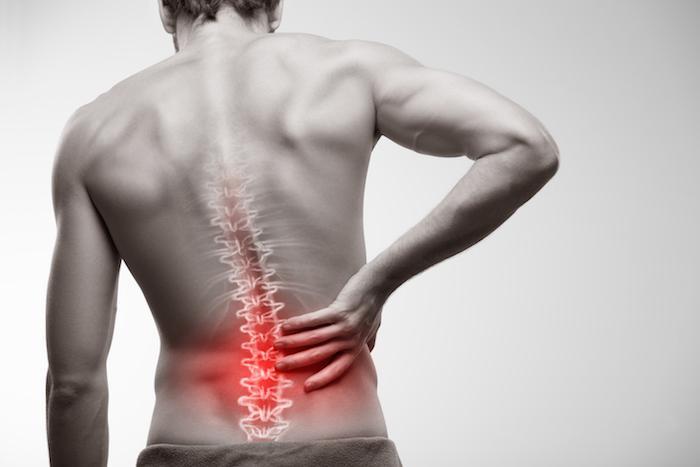
by best-mag | medicine
The lumbar spine contains a total of 5 intervertebral discs situated between the vertebral bodies. The primary functions of these discs are to1: Distribute compressive loads placed on the spine, providing shock absorption properties. Maintain the distance between the vertebral bodies during movement. Lumbar disc disease is the drying out of the spongy interior matrix of an intervertebral disc in the spine. Many physicians and patients use the term lumbar disc disease to encompass several different causes of back pain or sciatica. It is thought that lumbar disc disease causes about one-third of all back pain.
Lumbar disc Symptoms :
Pain, loss of muscle strength and loss of touch sensation may occur if this herniation causes the compression of the most proximal part of the nerve closely neighbouring the intervertebral disc material. Pain is in the distribution of the nerve compressed, usually down the back of the leg, side of the calf and inside of the foot (sciatica).
What are the symptoms of lumbar disk disease?
Intermittent or continuous back pain
Spasm of the back muscles
Sciatica
Muscle weakness in the legs
Numbness in the leg or foot
Decreased reflexes at the knee or ankle
Changes in bladder or bowel function
Lumbar disc Treatment :
Initial treatment in lumbar disc disease is one or two days of bedrest (although growing number of studies shows that it makes little difference) and pain relieving medications. In cases with ongoing pain despite conservative treatments, a surgical operation that will remove the compressing disc material, a microdiscectomy or discectomy may be recommended to treat a lumbar disc herniation.
Physical therapy, exercise and gentle stretching to help relieve pressure on the nerve root
Ice and heat therapy for pain relief
Manipulation (such as chiropractic manipulation)
Non-steroidal anti-inflammatory drugs (NSAIDs) such as ibuprofen, naproxen or COX-2 inhibitors for pain relief
Narcotic pain medications for pain relief
Oral steroids to decrease inflammation for pain relief
Epidural injections to decrease inflammation for pain relief
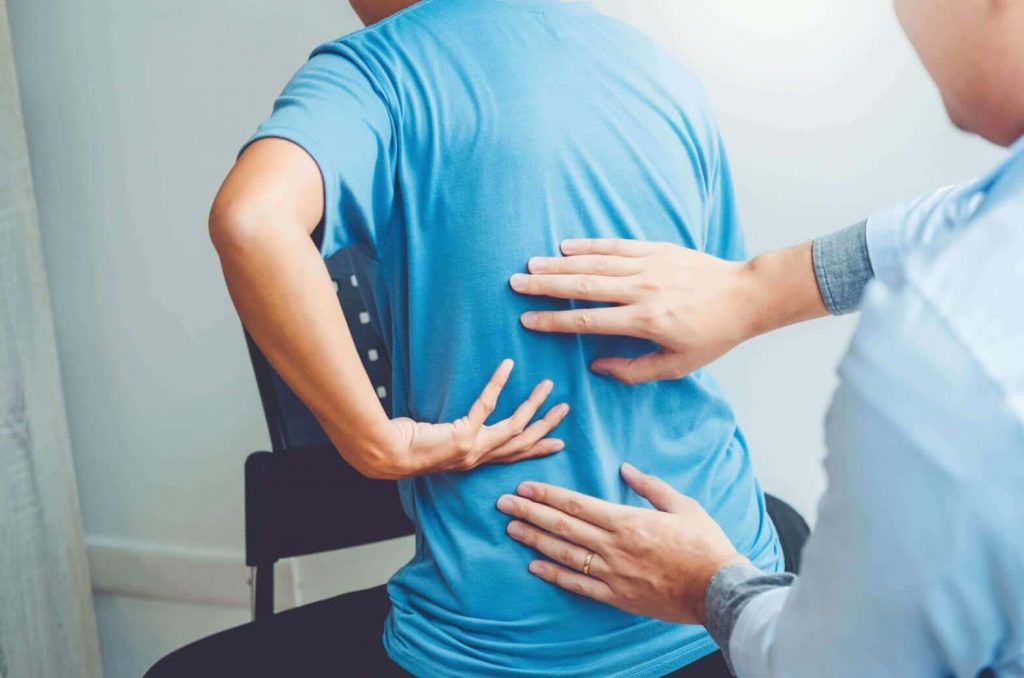
herniated disc
Spinal disc herniation is an injury to the cushioning and connective tissue between vertebrae, usually caused by excessive strain or trauma to the spine. It may result in back pain, pain or sensation in different parts of the body, and physical disability. The most conclusive diagnostic tool for disc herniation is MRI, and treatment may range from painkillers to surgery. Protection from disc herniation is best provided by core strength and an awareness of body mechanics including posture.
herniated disc Signs and symptoms:
Typically, symptoms are experienced on one side of the body only.Symptoms of a herniated disc can vary depending on the location of the herniation and the types of soft tissue involved. They can range from little or no pain, if the disc is the only tissue injured, to severe and unrelenting neck pain or low back pain that radiates into regions served by nerve roots which have been irritated or impinged by the herniated material. Often, herniated discs are not diagnosed immediately, as patients present with undefined pains in the thighs, knees, or feet.
herniated disc Treatment :
In the majority of cases spinal disc herniation can be treated successfully conservatively, without surgical removal of the herniated material. Sciatica is a set of symptoms associated with disc herniation. A study on sciatica showed that about one-third of patients with sciatica recover within two weeks after presentation using conservative measures alone, and about three-quarters of patients recovered after three months of conservative treatment. However the study did not indicate the number of individuals with sciatica that had disc herniations.
herniated disc Surgery:
Surgery may be useful when a herniated disc is causing significant pain radiating into the leg, significant leg weakness, bladder problems, or loss of bowel control.
Discectomy (the partial removal of a disc that is causing leg pain) can provide pain relief sooner than non-surgical treatments.
Small endoscopic discectomy (called nano-endoscopic discectomy) is non-invasive and does not cause failed back syndrome.
Invasive microdiscectomy with a one-inch skin opening has not been shown to result in a significantly different outcome from larger-opening discectomy with respect to pain.It might however have less risk of infection.
Failed back syndrome is a significant, potentially disabling, result that can arise following invasive spine surgery to treat disc herniation. Smaller spine procedures such as endoscopic transforaminal lumbar discectomy cannot cause failed back syndrome, because no bone is removed.
The presence of cauda equina syndrome (in which there is incontinence, weakness, and genital numbness) is considered a medical emergency requiring immediate attention and possibly surgical decompression.
causes of lumbar disc herniation :
Lumbar herniated disc most often affects people aged 35 to 50. Disc herniation symptoms usually start for no apparent reason. Or they may occur when a person lifts something heavy and/or twists the lower back, motions that put added stress on the discs.A single excessive strain or injury may cause a herniated disc. However, disc material degenerates naturally as one ages, and the ligaments that hold it in place begin to weaken. As this degeneration progresses, a relatively minor strain or twisting movement can cause a disc to rupture.
Disc herniation can occur in any disc in the spine, but the two most common forms are lumbar disc herniation and cervical disc herniation. The former is the most common, causing low back pain (lumbago) and often leg pain as well, in which case it is commonly referred to as sciatica.
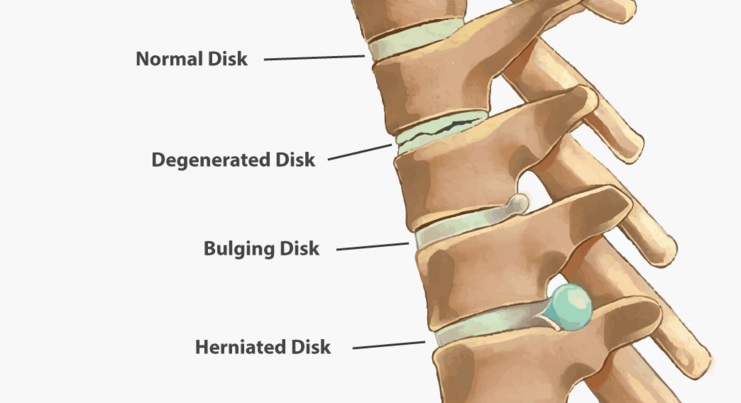
waist disk Frequently Asked Questions ؟
What is the cause of lumbar disc disease?
Lumbar disk disease is caused by a change in the structure of the normal disk. Most of the time, disk disease happens as a result of aging and the normal break down that occurs within the disk. Sometimes, severe injury can cause a normal disk to herniate. Injury may also cause an already herniated disk to worsen.
How serious is a compressed disc?
Permanent nerve damage.Without treatment, compressed nerve roots in the spine can be permanently damaged, leading to chronic pain, weakness, and loss of sensation. Other rare but serious complications of a protruding disc include cauda equina syndrome, saddle anesthesia, and bowel and bladder dysfunction.
What happens if a bulging disc goes untreated?
A severe case of a bulging disc can cut off nerve impulses, even causing permanent nerve damage. Additionally, you may experience sharp paints, incontinence, bowel movement irregularity, or even partial paralysis as the issue worsens.
What will a doctor do for a bulging disc?
Injections. If rest, pain relievers, and physical therapy don’t help with your pain, your doctor can inject a steroid medicine into the space around your spinal nerve. This is called an epidural injection. The steroid can help bring down the swelling, help you move more easily, and ease pain from a herniated disk.
Can a collapsed disc heal itself?
The good news is that in most cases — 90% of the time — pain caused by a herniated disc will go away on its own within six months. Initially, your doctor will likely recommend that you take an over-the-counter pain reliever and limit activities that cause pain or discomfort.
Is walking good for bulging disc?
Absolutely. Walking is an excellent choice for patients with herniated discs, as it stimulates blood flow and oxygen to the cells. It also helps keep your discs hydrated, which is important for healing. Other low-impact aerobic activities to try are swimming and cycling.
Can you push a bulging disc back in?
If you have back pain from a bulging disc, do not have your friend try to force it back into place. This will likely increase, rather than relieve, your pain.
How long does a ruptured disk take to heal?
The average amount of time it takes for a herniated disk to heal is four to six weeks, but it can get better within a few days depending on how severe the herniation was and where it occurred. The biggest factor in healing a herniated disk is time, because most often it will resolve on its own.






























